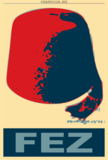US Defense Secretary Donald Rumsfeld said earlier in a radio interview that it was "very likely" that the explosives were removed before the war by Iraqi president Saddam Hussein, but offered no concrete evidence.
"I guess the first thing to say about it is that first reports are almost always wrong," he said in an interview with a Philadelphia radio station.
"And people who use hair-trigger judgement to come to conclusions about things that are fast moving frequently make mistakes that are awkward and embarrassing," he said.
Meanwhile, in reality:
"The photographs are consistent with what I know of Al Qaqaa," said David A. Kay, a former American official who led the recent hunt in Iraq for unconventional weapons and visited the vast site. "The damning thing is the seals. The Iraqis didn't use seals on anything. So I'm absolutely sure that's an I.A.E.A. seal."
One weapons expert said the videotape and some of the agency's photographs of the HMX stockpiles "were such good matches it looked like they were taken by the same camera on the same day."
Independent experts said several other factors - the geography; the number of bunkers; the seals on some of the bunker doors; the boxes, crates and barrels similar to those seen by weapon inspectors - confirm that the videotape was taken at Al Qaqaa.
"There's not another place that you would mistake it for," said Dean Staley, the KSTP reporter, who now works in Seattle.
The accidental news encounter began last year after the invasion, Mr. Staley recalled in an interview. Their Army unit arrived in the region on Friday, April 11, and made camp. The Fifth Battalion of the 101st Airborne's 159th Aviation Brigade flew helicopter missions from the camp in the Iraqi desert, moving troops and supplies to the front.
A week later, on Friday, April 18, two journalists recalled, they joined two soldiers who were driving in a Humvee to investigate the nearby bunkers. Among other things, wandering inside the cavernous buildings offered the prospect of relief from the desert sun.
"It was just by chance that we were able to go," said Joe Caffrey, the team's photographer. "They wanted to go out and we asked to tag along."
Mr. Caffrey provided The New York Times with the latitude and longitude of the camp, which places it between 1.5 and 3 miles southeast of Al Qaqaa bunkers. A commercial satellite photograph of the region shows that the camp was close to the storage site. Mr. Caffrey said the soldiers used bolt cutters to cut through chains with locks on them, as well as seals. He said the seals appeared to be lead disks attached to very thin wires that were wrapped around the doors of the bunker entrances, forming a barrier easily cut in two.
They visited a half dozen bunkers, he said. The gloomy interiors revealed long rows of boxes, crates and barrels, what independent experts said were three kinds of HMX containers shipped to Iraq from France, China and Yugoslavia.
The team opened storage containers, some of which contained white powder that independent experts said was consistent with HMX.
"The soldiers were pretty much in awe of what they were seeing," Mr. Caffrey recalled. "They were saying their E.O.D. - Explosive Ordinance Division, people who blow this kind of stuff up - would have a field day."
The journalists filmed roughly 25 minutes of video. Mr. Caffrey added that the team left the bunker doors open. "It would have been easy for anybody to get in," he said.
Mr. Staley recalled that during the drive back to camp, they saw a red Toyota pickup truck with some Iraqis in it. "Our impression was they were looters," he said. "This was a no man's land. It was a huge facility, and we worried that they were bad guys who might come up on us."
 Rising Hegemon
Rising Hegemon
1 comment:
Incredible, that is lovely. Think about all of the reading through and composing you could do this... Chilly in the winter though.
Diablo III Gold
Billig WoW Gold
Post a Comment